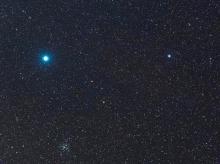Listen to today's episode of StarDate on the web the same day it airs in high-quality streaming audio without any extra ads or announcements. Choose a $8 one-month pass, or listen every day for a year for just $30.
You are here
Aludra
From here on Earth, the big dog among the stars is Sirius, the brightest star in the night sky. It’s the leading light of Canis Major, the big dog, so it’s also known as the Dog Star.
And it really is a bright star — a couple of dozen times brighter than the Sun. Yet it looks so bright mainly because it’s close — less than nine light-years away.
In fact, if you lined up all the stars in the outline of Canis Major at the same distance, Sirius would look like a candle in a field of searchlights. The constellation is home to some truly impressive stars. And perhaps the most impressive of all is Aludra, at the tip of the dog’s tail.
The details are a bit blurry, because there’s a wide range in measurements of the star’s distance. Even so, we know that Aludra is a blue supergiant. It’s more than a hundred thousand times brighter than the Sun. It’s also more than 50 times wider than the Sun, and 15 to 20 times more massive.
We also know that Aludra is quite young, but it’s already nearing the end of its life. Because of its great mass, it “burns” through its nuclear fuel in a hurry. Within a few million years, it’ll no longer be able to sustain the reactions in its core. The core will collapse to form a neutron star or a black hole, while the outer layers explode as a supernova. For a brief moment of cosmic time, that’ll leave no doubt about the big dog among the stars of the big dog — Aludra will outshine them all.
Script by Damond Benningfield




